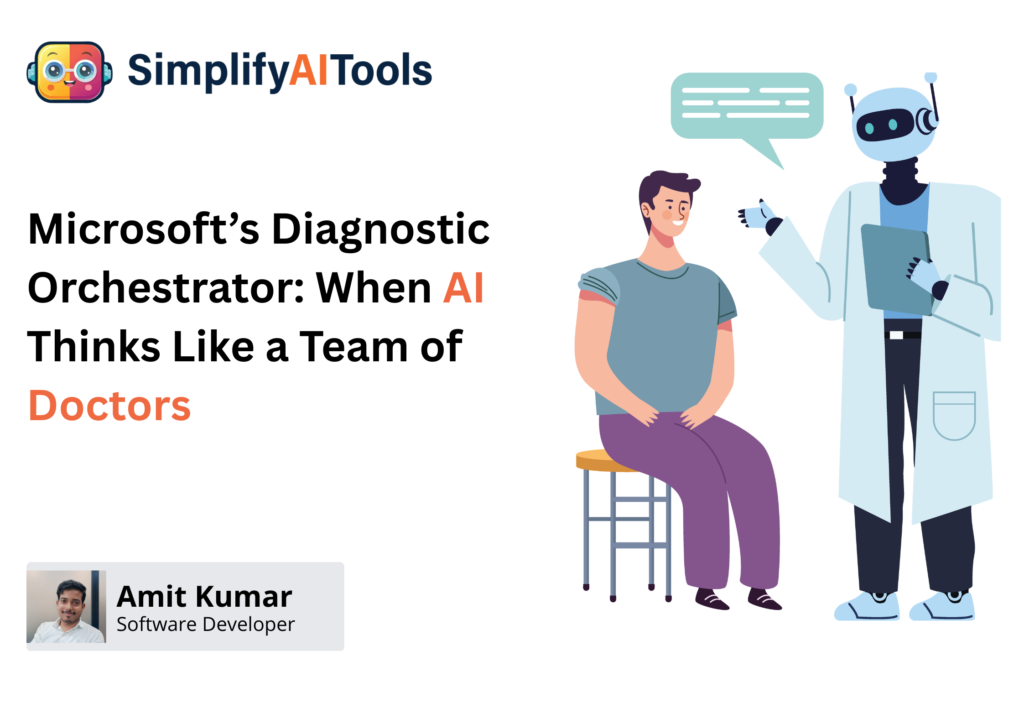Microsoft has unveiled a groundbreaking innovation—AI Diagnostic Orchestrator (MAI-DxO)—marking a transformative step in how AI assists in medical diagnosis. Unlike conventional single-shot AI tools, MAI-DxO simulates a panel of expert clinicians, engaging in dynamic, debate-driven diagnosis using multi-agent collaboration.
It doesn’t rely on just one AI model. Instead, it orchestrates agents powered by OpenAI’s o3, Google Gemini, Anthropic Claude, Meta’s Llama, and xAI’s Grok, enabling cross-model reasoning and decision-making.
🔬 What Is Microsoft’s Diagnostic Orchestrator?
MAI-DxO is not just another AI chatbot for medicine. Rather, it’s a multi-agent diagnostic system designed to operate like a team of real doctors. Instead of instantly giving you a diagnosis, it simulates the entire clinical reasoning process—asking questions, evaluating answers, and refining conclusions based on real-time feedback.
🧩 Key Components of MAI-DxO
1. Initial Intake
To begin with, MAI-DxO collects structured inputs such as patient history, symptoms, and background context—much like a REST API. This mimics the initial interaction between a physician and a patient.
2. Interactive Questioning
Next, the AI agents begin probing. They ask intelligent follow-up questions to clarify ambiguous or missing details, just as doctors would do during patient interviews.
3. Test Orchestration
After gathering the needed context, specialist agents collaboratively decide which diagnostic tests (e.g., lab or imaging) are necessary. This step not only improves accuracy but also reduces redundant testing by up to 70%.
4. Final Diagnosis
Finally, MAI-DxO synthesizes all available data and presents a high-confidence diagnosis. Impressively, it achieved 85.5% diagnostic accuracy, outperforming human doctors (20%) in benchmarks based on 304 complex cases from the New England Journal of Medicine.
⚙️ Why MAI-DxO Matters in Modern Healthcare
✅ Goes Beyond One-Shot Prompting
Unlike traditional large language models (LLMs), MAI-DxO doesn’t forget. It remembers previous interactions, adjusts based on new data, and follows a step-by-step diagnostic chain, offering dynamic reasoning rather than static outputs.
✅ Model-Agnostic & Modular
Importantly, MAI-DxO is vendor-agnostic, integrating top-tier models from multiple providers. This modular approach allows more robust decision-making without being locked into one ecosystem.
✅ Optimizes Cost & Accuracy
Moreover, by prioritizing high-yield tests, it helps reduce unnecessary costs while significantly improving diagnostic precision—making it ideal for value-based care models.
✅ A Step Toward Medical Superintelligence
Experts believe this system represents an early version of medical superintelligence—a future where AI not only supports but potentially outperforms human clinicians in diagnostics.
🔮 What’s Next for Microsoft MAI-DxO?
Although it’s not ready for clinical rollout yet, the trajectory is promising. Here’s what could be coming:
-
🔄 EHR Integration for real-time access to patient data
-
🧠 More Specialist Modules, such as radiology and pathology
-
🔍 Transparent Audit Trails to explain each AI agent’s reasoning—crucial for regulatory trust
🧠 Frequently Asked Questions (FAQs)
❓ Is there an AI tool for medical diagnosis?
Yes, Microsoft’s AI Diagnostic Orchestrator (MAI-DxO) is one of the most advanced AI diagnostic systems available. It achieves 85.5% accuracy in complex diagnostic tasks.
❓ What is the Microsoft AI Diagnostic Orchestrator (MAI-DxO)?
MAI-DxO is a multi-agent AI diagnostic engine that simulates a team of medical experts. It questions, tests, debates, and verifies before making a decision—significantly improving diagnostic accuracy.
❓ What are the four stages of responsible AI by Microsoft?
Microsoft outlines responsible AI in four key principles:
-
Fairness
-
Reliability & Safety
-
Privacy & Security
-
Transparency & Accountability
These are embedded into systems like MAI-DxO to ensure ethical and secure AI deployment.
❓ What is Microsoft’s AI tool for developers?
While MAI-DxO focuses on healthcare, developers can explore tools like Azure AI Studio, GitHub Copilot, and Semantic Kernel for building intelligent applications.
❓ Can I use or download MAI-DxO?
As of now, MAI-DxO is in research and pilot testing. It’s not publicly available for download or clinical use, but Microsoft is expected to release pilot versions for testing in real-world healthcare settings soon.
🔑 Related Keywords
Microsoft AI Diagnostic Orchestrator, MAI-DxO, AI diagnostic orchestrator, AI in medical diagnosis, diagnostic AI accuracy, Microsoft medical AI, multi-agent diagnostic system, OpenAI o3 healthcare, AI model orchestration, responsible AI in medicine.
🧭 Final Thoughts
Microsoft’s MAI-DxO is more than an innovation—it’s a vision for a next-gen healthcare system where AI acts as a knowledgeable, collaborative team member. As research advances, tools like MAI-DxO could fundamentally change how the medical field diagnoses, treats, and cares for patients.
📚 Explore More on AI in Business & Diagnostics
Want to understand how AI is reshaping industries beyond medicine?
👉 Cost of Implementing AI – A Clear-Cut Budget Guide for Businesses
Looking for the latest breakthroughs in AI tools and platforms?
👉 Explore more insightful blogs on Simplify AI Tools

